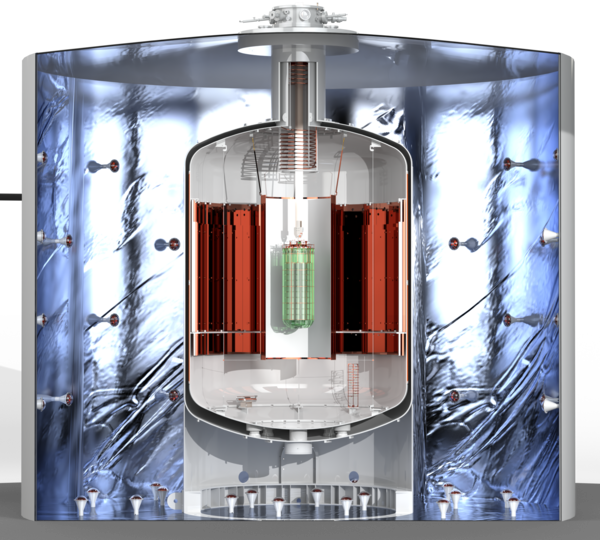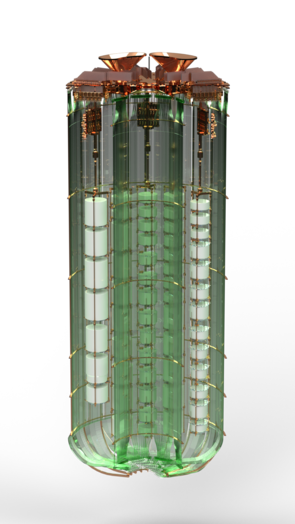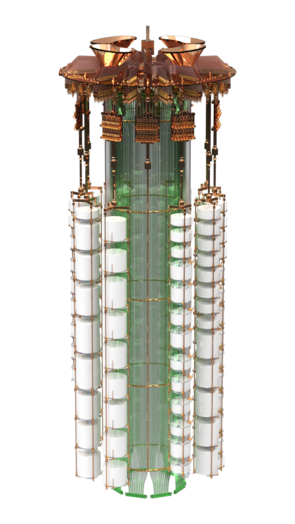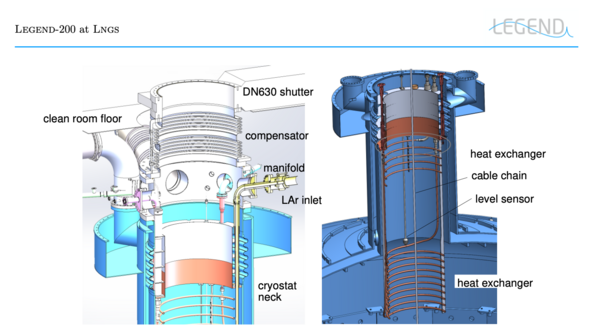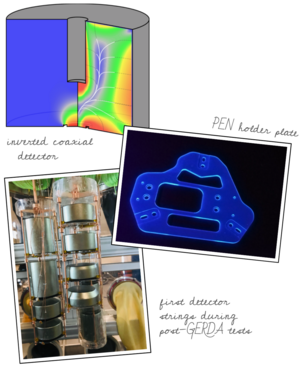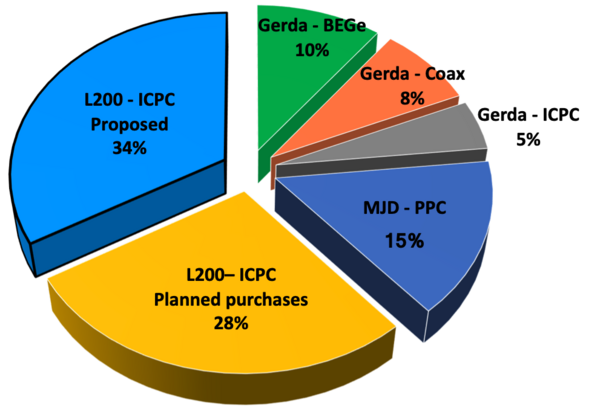LEGEND-200
First Stage
The construction of the large infrastructure that LEGEND-200 requires, implies the use of major resources and time. Experience shows that such processes last several years and motivate major redesigns. The reutilization of GERDA facilities for LEGEND-200 constitutes a very economical and time efficient option. Two main features allow us to proceed with LEGEND-200:
- The background in GERDA is dominated by sources close to the detectors like cables, 42Ar and detector surface contaminations. External sources of radiation are efficiently reduced by the water and the liquid argon (LAr) shield to ensure sufficiently low background rates for LEGEND-2001. Muon induced events are tagged efficiently by the water Cherenkov detector and the liquid argon instrumentation.
- The cryostat, especially the aperture of the neck, is large enough to house 12 detector strings with 200 kg of mass.
The existing GERDA infrastructure is therefore a suitable facility for LEGEND-200. The installation finished in summer 2022 and LEGEND-200 is currently taking physics data with 140 kg of 76Ge detectors. Early 2024 the remaining detectors will be deployed to bring LEGEND-200 to its designed capacity.
► The existing detectors from MAJORANA and GERDA were redeployed in the cryostat along with additional detectors that are being fabricated from new material. Recent R&D has shown that point-contact detectors of 1.5 − 3 kg are now possible. These are much larger than the detectors used by MAJORANA and GERDA. LEGEND-200 is taking physics data since early 2023.► The experiment will probe the 0νββ decay of 76Ge with a sensitivity of τ½0ν> 1027 yr at 90% confidence level (C.L.) corresponding to a range of the effective Majorana neutrino mass of mββ < 33 − 71 meV within about 5 years. Existing enriched detectors from the previous MAJORANA and GERDA experiments as well as new detectors will be used resulting in a maximum total mass of 200 kg of source material.► LEGEND-200 only requires background decreased by a factor of 5 below the measured levels of MAJORANA and GERDA. It is therefore a natural step towards 1000-kg (LEGEND-1000) that will provide discovery potential that encompasses the inverted hierarchy mass region, while only necessitating an additional factor of 6 reduction in background. |
To accommodate the extra strings, some re-design of the piping through the neck has been done for the detectors deployment. The detectors and liquid argon instrumentation are assembled in the clean room above the cryostat in a glove box which is flushed with nitrogen to reduce/avoid radon deposition on the detectors and protects the insulating groove between the detector p+ and n+ electrodes by an inert atmosphere. The detectors are assembled into strings and, together with the liquid argon instrumentation, placed inside the lock. When the lock is closed several pumping and purging cycles follow.
The entire assembly is lowered through the cryostat neck into the main volume. Thus the diameter of the neck is a limiting aperture. The neck of the cryostat has a nominal diameter of 800 mm while the minimum required for a maintenance hole is only 550 mm. The larger aperture is what allows the expansion of the detector mass to about 200 kg.
The cryogenic infrastructure of the cryostat includes the liquid argon and nitrogen storage tanks, a valve box which houses manual and remotely controlled valves for LN2 / LAr and a radon trap, and piping inside the cryostat. The latter includes two copper spirals as heat exchangers for the cooling of LAr with LN2 , a LAr filling line, a drainage pipe, temperature sensors at different positions and several devices for the fill level measurement. The available aperture for the detectors in the neck is reduced because of these pipes and sensors such that this opening becomes the limiting cross section. For LEGEND-200 the installation has been replaced to enlarge the area for detectors and LAr instrumentation.
The water tank is equipped with 66 PMTs. Easily accessible PMTs were repaired since GERDA stopped data taking and the water tank was emptied. This situation also provided the opportunity to inspect the outer wall of the cryostat for corrosion or other damage.
LEGEND-200 Cryostat
The LEGEND 200 cryostat counts with an upgraded fibber shroud configuration designed to both accommodate the increased number of detectors and to improve the light collection capabilities of the liquid argon instrumentation. Moreover, they new system counts with the LEGEND Liquid Argon Monitoring Apparatus (LLAMA) to monitor the purification levels of the LAr. LLAMA is located below the germanium detectors array, installed at the bottom of the LEGEND cryostat.
Fibers for 12-strings
Fiber shroud configuration for the 14 LEGEND-200 strings. The green optical fibers not only carry the light from the scintillation events to the light collectors, but also act as wave-shifters for the blue light coming from the scintillation process. The light emitted by the LAr is in the UV regime and therefore very challenging to fully collect. For this reason, the wavelight is first shifted from UV to blue by TPB (Tetraphenyl butadiene) and then it is converted to green through the optical fibers.
Key technnologies
► Large mass HPGe detectors, inverted coaxial point contact (ICPC) detectors2- active mass up to 3 kg- excellent PSD performance3► Improved LAr scintillation light read-out► Elaborate material selection- radiopurity (electroformed copper, underground Ar for L1000)- optically active materials (PEN structures)4► Enhanced active background rejection, e.g. delayed-coincidence cuts for muon-induced 77mGe5 |

